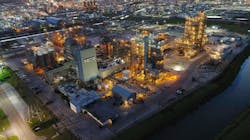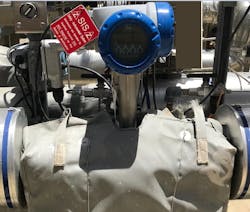Global chemical company BASF recently opted for new Coriolis flowmeter technology as the centerpiece of its Freeport, Texas, plant’s safety instrumented system (SIS). With its price versus performance, smaller footprint, entrained gas management features and in-situ verification capabilities, the new flowmeter technology improves reliability and decreases downtime for critical process systems.
Plant operators look for replacement for aging equipment
BASF’s Freeport plant manufactures superabsorbent polymer (SAP), which absorbs and retains large amounts of liquids. The water-absorbing polymer has thousands of uses, ranging from diapers, masking tape and artificial snow, to hot and cold therapy packs, motionless water beds and even grow-in-water toys.
According to Daniel Siddiqui, BASF’s instrumentation and electrical lead engineer, plant operators needed to replace flowmeter instrumentation for the SIS, an engineered set of hardware and software controls used on critical process systems. The previous mass meter equipment was under review for replacement and BASF was researching options to upgrade to newer technology. Siddiqui said, “BASF wanted to explore options that would maintain our high safety standards but were economical.”
The plant’s SIS was required to meet safety integrity level (SIL) 3, a measure of system performance and probability of failure for a safety instrumented function, as defined in the IEC 61508 functional safety standards. Among other items, SIL 3 requires a SIS safety instrument with an override for any unusual conditions. Redundant flowmeter instruments are required to alert operators to any flow deviations and trigger a safety alarm. Every time the deviation is greater than 5%, the SIS system shuts down the production line.
Operators knew that selecting the right instrumentation was critical to minimizing any intermittent or false alarm trips that would result in production line shutdown. Apart from the economic burden from loss of production and wasted material, premature stopping under full load — rather than normal ramp down for shut off — can introduce significant equipment wear and tear.
“We reached out to KROHNE,” said Siddiqui. BASF tested the KROHNE meter at its central laboratory located in Germany and approved it for SIS service.
After reviewing a variety of options, BASF chose a design featuring two KROHNE OPTIMASS 6400 Coriolis twin bent tube mass flow meters in a series to create the required redundancy.
The flowmeters are available in sizes ranging from DN 08 to 250 and can be made in stainless steel 316L, Hastelloy C22 and Duplex steel UNS S31803. The BASF installation includes 2-inch meters — the external meter is made of 316 stainless steel, while the internal is composed of Hastelloy.
Compliant with the User Association of Automation Technology in Process Industries (NAMUR) standard installation lengths, the OPTIMASS 6400 operates in high temperatures up to 752°F (400°C), as well as cryogenic applications down to -328°F (-200°C). It also handles pressures up to 200 bar (2,900 psi). It features the new MFC 400 signal converter, which offers fast, completely digital signal processing as well as enhanced diagnostic and status indications.
Price versus performance and entrained gas management
Plant operators reviewing options determined that the price, along with performance reliability, on the OPTIMASS 6400 was superior to other options. If operators obtained a reading showing a deviation or another issue with a process monitoring parameter, the meter helped identify the issue in advance, while still performing reliably under the abnormal conditions.
The smaller physical footprint of the meters selected was another benefit making installation easier. The KROHNE OPTIMASS 6400 fit into the existing space available without major piping modifications.
With the OPTIMASS 6400, a proprietary isolation system allows for the meters to be close coupled or mounted flange to flange. The unique design ensures that tube vibration has no effect on performance when meters are mounted flange to flange. The meters have an oscillator that moves the pipe, causing fluids to swirl, which creates a mechanical distortion between the pipe’s inlet and outlet. The sensor upstream of the oscillator picks up this vibration before the outlet. With other designs, tube vibrations migrate through the piping, causing errors if the meters are close coupled.
In addition, for the same pressure drop, BASF was able to select a smaller diameter because of the lower pressure drop through the meter compared to other options. One other benefit BASF noted was optimizing the stocking of spare parts ensuring that all meters received have the required entrained gas capability.
“We got excellent support from KROHNE and were able to get two meters, which allowed us to stay under our approved budget,” said Siddiqui.
In-situ verification reduces downtime due to calibration requirements
Safety instruments such as meters must be calibrated regularly, and operators are required to establish a proof test interval. Using the OPTICHECK on-site verification tool, BASF can fulfill third-party requirements for independent verification of instruments. BASF connects the tool in-line on-site to gather measuring data to ensure that the flowmeter is performing within ±1% of the factory calibration. The baseline can be historic repair data from the factory or on-site test results after performing a full verification. OPTICHECK also provides detailed reports for proof test documentation of safety loops.
The in-situ verification enables the operators to keep the meter operating longer, rather than having to pull the meter out of line, package it, send it off to get calibrated to a known standard, and then shipping it back and installing it.
Meter performing well since startup
Plant operators started using the new Coriolis meter technology for the SIS in February 2020. According to Siddiqui, the system has been operating well, providing accurate readings and offering increased confidence in the SIS application.
“By using the KROHNE meters we did not compromise safety, and at were able to maximize cost efficiencies while receiving free startup support,” said Siddiqui.
Al Dhanji is a district sales manager for KROHNE Inc.

